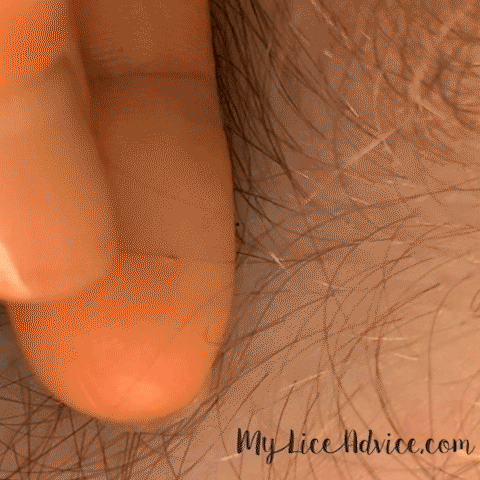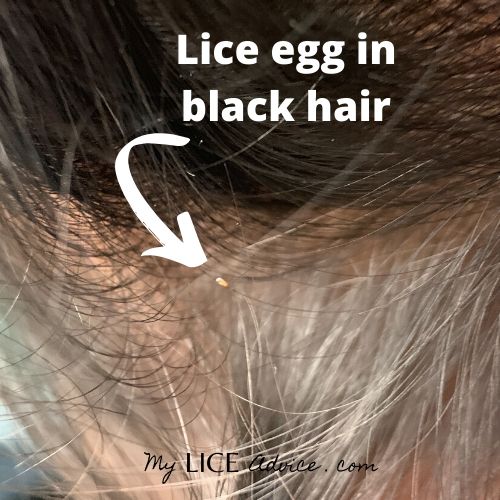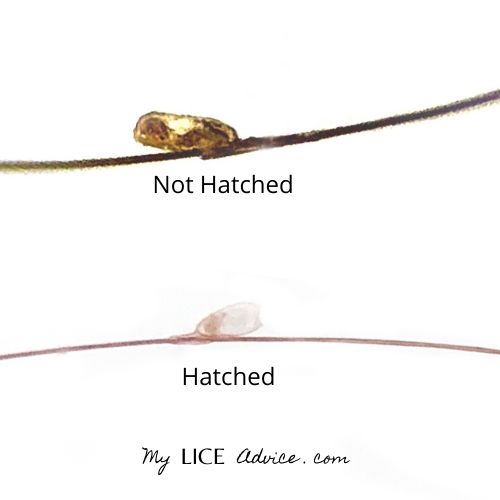Dead vs Live Nits: Color of Lice Eggs
Loaded with pictures, discover the different colors of lice eggs and how you can determine the difference between live and dead nits in the hair.
Question:
What color are lice eggs? How can I tell if lice eggs are dead?
Answer from a Lice Expert:
One of the most misunderstood things about lice is what lice eggs look like, which is why this article is loaded with pictures and videos.
More specifically, most people are confused what color are lice eggs and how can you know if they are dead or not. Whether you’re checking your child for lice or are trying to determine if what you’re seeing is dead or live nits, you’ll find the answers here.

Lice eggs and nits are the same thing.
To start off let's get something straight... Nits and lice eggs are the same thing! Don't make this more complicated then it needs to be. The two words (nits and lice eggs) will be used interchangeably in this article.
This article discusses the following:
Color/Appearance of Lice Eggs
Super Lice Eggs
Color of Dead Lice Eggs
How To Remove Dead Lice Eggs from Hair
Live vs. Dead Lice Eggs
How Long Dead Nits Stay in Hair
Again, if you are new to lice, lice eggs and nits are the same things. The two words will be used interchangeably in this article.
Dead Nits vs Lice Lice Eggs Video

Let me introduce myself...

Hi there! I'm a lice expert, lice coach, Registered Nurse, and the creator of My Lice Advice. I help people with lice every day in my lice treatment center, in school districts, and in government work. But the thing I love the most is empowering parents to get rid of head lice in ONE DAY at home!
You can eliminate lice in one day using the same proven professional technique I use in my lice center on your child. Follow along with the Step-by-Step Video System, and when you're done with the videos you're done with lice. PERMANENTLY!

What Do Lice Eggs Look Like?

Lice eggs are tiny (about the size of a poppyseed), and they blend in pretty well with hair. If you aren’t looking closely, you are likely to miss them. Lice eggs and dandruff are often mistaken for one another, but some of the key differences are that lice eggs are tear-drop shaped and glued to the side of the hair strand.
The tell-tale sign that what you are finding is a nit is that a nit cannot be flicked, blown, or brushed away. Aside from a high-quality lice comb, the only way to remove a lice egg from the hair strand is to squeeze it between two fingers and manually drag it down the entire hair strand.

Hot Spots
You will find lice eggs in the “hot spots” of the head. These hot spots are the places that lice like to lay their eggs the most. They are behind both ears, the nape of the neck, and the crown of the head.

What Color Are Lice Eggs?
A common misunderstanding is that nits are white. Nits have a shiny appearance and can appear white, especially in dark hair. But most lice eggs are not white. They vary in color from light golden to dark brown, depending on how close they are to hatching.

Golden
When lice lay their eggs on a hair strand, the eggs are two-toned--often a golden color with a dark brown circle inside. The dark circle on the inside of the egg is a small lice bug growing inside the egg.

Brown/Black
Over the next few days, that lice bug grows inside the egg. As it matures and grows inside, the nit will appear darker and darker until it seems completely brown, almost black. These very dark nits are the nits that are just about to hatch.

Hatching
Most lice hatch somewhere between 1-2 weeks, but this can vary greatly depending on climate and other factors.

Transparent/White
After the lice bug hatches out of the egg, the eggshell remains on the hair strand. Lice eggs left over after the bug has hatched will appear to be white or translucent because all you see leftover is a shell or casing with no bug inside.
Similar to a chicken egg, after you crack open the egg and remove the insides, all you have left is a white shell.
Hatched or Not Hatched:
That is the Question
There really isn't a way to tell whether or not lice eggs are alive or dead. What you can tell is this:
- Whether or not they are hatched (meaning they no longer have a bug inside, therefore are no longer a threat).
- Whether or not they are "not yet" hatched (meaning there is still a bug inside the egg, therefore they are a threat).
Here's the way to tell the difference:

White/Clear Nits = Already Hatched
Once lice eggs are hatched they are translucent/clear in color. For those with dark hair, like the picture above, those eggs appear white in the hair.
Think of lice eggs like any other egg... once a lice bug hatches and leaves the egg all you are left with is a shell. That's what you're seeing when you see white lice eggs/nits in the hair. You are seeing an old, left over shell that is glued onto the hair, there is no bug inside of "white" lice eggs/nits. (Unfortunately those white eggs/nits won't "fall off" because they are glued to the hair strand).
Since there is not bug inside those old white lice eggs are no longer a threat.
Yellow/Brown/Black Lice Eggs = Have Not Hatched Yet

Dark lice eggs (brown or black) are your BIGGEST threat. Many mistakenly believe that these lice eggs are "dead" when the opposite is true!
When lice eggs are first laid they are a light golden color, but as the lice bug in the egg grows the darker the lice egg becomes. Think of lice eggs like bananas...the darker they are the "riper" they are. When lice eggs are dark brown or black they are "very ripe" and are just about to hatch!!
Do Lice Eggs Change Color After They Die?

Unfortunately, many mistakenly believe that dark brown lice eggs are dead, so they don't worry about removing them from the head. As was just explained in the paragraph above dark lice eggs are NOT dead. The opposite is true! The darker the lice egg, the closer it is to hatching. If you find dark lice eggs in the hair, then you can plan on those eggs hatching within just a day or two.
Some lice kits claim to kill lice eggs. In my opinion, this is EXTREMELY misleading. Some pesticides kill a few lice eggs (I'm talking about a very small percentage of eggs on the head). And guess what? It only takes two lice eggs (one male and one female) to hatch and re-infest your child all over again! So please don't believe the lie that lice kits kill lice eggs, they do not.
I'm going to repeat this one more time clearly...
Lice eggs DO NOT turn black/brown because they are dead.... They change color (brown/black) because they are getting closer to hatching!

What Color Are Dead Lice Eggs?

You can't determine whether or not lice eggs are dead by their color. As explained before, lice eggs that are "hatched" are white/translucent, whereas lice eggs that have not hatched yet will be golden, brown, or black.
You’ll find a lot of products advertising “kills lice eggs,” but don’t be fooled by these gimmicks. Most lice treatments only kill a small percentage of lice eggs... and if you leave those eggs in the hair then they will hatch and just re-infest your child over and over again.
Live vs. Dead Lice Eggs
As explained above, lice don't change in appearance when they are "dead." So, instead of thinking about live vs. dead lice eggs, you should think hatched vs. unhatched.
Hatched lice eggs = No lice bug inside anymore = No threat.
Unhatched lice eggs = There is a still a lice bug inside = Lice will hatch and re-infest your child again.
Lice eggs that have already hatched will be transparent/translucent in color and usually appear white in the hair. These nits no longer have lice inside of them, so they are not a threat. Unhatched or “viable” nits have color to them, they begin golden brown and then become darker the closer they are to hatching.

It is nearly impossible to tell the difference between hatched and unhatched nits on the entire head with the naked eye. In the step-by-step video system I walk you through how to kill and remove every last lice egg in one session, hatched and unhatched. That way you can be DONE with lice in one treatment and never have to worry about lice eggs again.
Why Is It So Hard to Get Rid of Lice?
Now that you know what you're looking for I want to talk briefly about your biggest worry (that your child actually has lice) and the question I get asked by parents around the world that have been battling lice….

Parents around the world are all asking me the same question…. "Why is it so much harder to get rid of lice now?"
Lice have become immune to everything that used to work in the past. Perhaps you remember your mom using a typical lice treatment or mayonnaise and that doing the trick. The new strain of head lice is no longer killed by those treatments, that’s why lice today are termed by people, “super lice,” because they are immune to those treatments.
I’ve cured thousands of people of lice in my lice center and let me tell you, I don't do it with over-the-counter lice treatments.

Most people struggle with lice because they focus all of their attention on killing lice bugs and not enough attention on GETTING RID OF LICE!
If you want to get rid of lice you have to address all 3 of the problems of lice:
- Lice Bugs
- Lice Eggs
- Getting Lice Back
The best way to get rid of lice is to tackle all 3 of these problems at the same time, which is what I teach in my step-by-step video system.
So, if you discover your child HAS lice, don't panic. Just head over to the video system. Follow along with the videos and you'll be done with lice by the end of the day.


SUPER LICE!

Super lice and regular head lice are virtually the same bugs, except super lice has mutations that make them (and their eggs) much more difficult to kill. Almost ALL lice bugs are super lice these days. In fact, the studies show that over 98% of head lice are now super lice.
Super lice basically means that lice today are immune to lice kits and other treatments. You can read about super lice here.
Basically, super lice is the new kind of lice that everyone has and it's the reason lice is so hard to get rid of nowadays. That's why lice kits and home remedies don't work. And that's why I created the step-by-step video system, to teach you how to get rid of lice the same way that lice professionals like myself do.
Regular Lice Eggs vs. Super Lice Eggs

Like the adult bugs, super lice eggs look and function the same way, they're just immune to lice treatments. The difference is that lice eggs from 30 years ago without the super lice mutation could be affected by pesticides, that might prevent them from hatching. Lice kits and other treatments don't kill lice eggs anymore. Lice eggs today are immune to them, so they just keep hatching if you leave them in the hair.
If you focus only on killing lice and not removing eggs, you will just go around and around in a a cycle where lice keeps coming back.
How Do You Know If Nits Are Dead?

Unfortunately, because lice eggs do not change in appearance once they die, there is no way to know if nits are dead or alive until they hatch. And you do not want to wait around and “see” if the lice eggs hatch!! Because one they hatch then you'll be dealing with lice all over again. The best thing to do is to kill and remove all lice bugs and lice eggs in one session. That's how lice professionals like myself get rid of lice and that's what you'll do with the step-by-step video system.
How Long Can Dead Nits Stay in Hair?

Potentially, dead nits can stay in the hair forever. Once lice glue a lice egg to the hair strand, it will not come off unless removed from the hair. Lice eggs stick to the hair, so eventually, over time, they will move from near the scalp to further down the hair strand as the hair grows over the years. But, they will never fall out! Here is a picture of a girl who had lice for 3 years. Notice the dark brown unhatched/viable lice eggs are close to her scalp, and the white, already hatched lice eggs go all the way down her hair.
Also, lice eggs become more challenging to remove the longer they are in the hair, not less complicated. They start to decay and “break down” overtime on the hair strand, which seems to make them stick better to the hair strand.
I know it’s difficult and overwhelming to get all of those little lice eggs out of your child’s hair, especially if she has had it for some time, but with the step-by-step video system you'll be able to get it done by the end of the day. And you won't have to worry about lice coming back ever again.
Summing it Up...
Generally speaking, “live,” or unhatched nits are golden/brown/ or black. They become darker the closer they are to hatching. Hatched eggs, usually appear translucent and can look white in the hair. It is impossible for someone to determine whether they are finding live or dead nits when looking through the hair.
Lice treatments and home remedies do not kill lice eggs. The only thing that kills lice eggs is the professional technique I teach in the Step-by-Step Video System which is why it’s guaranteed to get rid of lice in ONE DAY without needing any retreatments.
All the best,


Theresa is a Registered Nurse and lice expert with years of experience curing children of lice. She owns a lice treatment center in the US which is where she perfected the Step-by-Step Video System proven to get rid of lice. She also works with government agencies and schools helping those with the worst head lice cases in America.
Her greatest passion is empowering parents by teaching parents online how to do a professional lice treatment on their child at home. She is the Lice Coach for the My Lice Advice Step-by-Step Video System.

